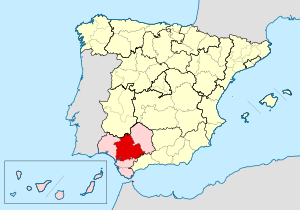Archdiocese of Seville
|
Archdiocese of Seville
|
|
| Basic data | |
|---|---|
| Country | Spain |
| Diocesan bishop | Juan José Asenjo Pelegrina |
| Emeritus diocesan bishop | Carlos Cardinal Amigo Vallejo OFM |
| Vicar General | Francisco Ortiz Gomez |
| surface | 14,036 km² |
| Parishes | 263 (2017 / AP 2018 ) |
| Residents | 1,941,825 (2017 / AP 2018 ) |
| Catholics | 1,886,300 (2017 / AP 2018 ) |
| proportion of | 97.1% |
| Diocesan priest | 425 (2017 / AP 2018 ) |
| Religious priest | 225 (2017 / AP 2018 ) |
| Catholics per priest | 2,902 |
| Permanent deacons | 62 (2017 / AP 2018 ) |
| Friars | 314 (2017 / AP 2018 ) |
| Religious sisters | 1,583 (2017 / AP 2018 ) |
| rite | Roman rite |
| Liturgical language | Spanish |
| cathedral | Catedral de Santa María de la Sede |
| address | Apartado 6 Plaza Virgen de los Reyes s / n 41004 Sevilla España |
| Website | www.diocesisdesevilla.org |
| Suffragan dioceses |
Diocese of Cádiz y Ceuta Diocese of Córdoba Diocese of Huelva Diocese of Canary Islands Diocese of Jerez de la Frontera Diocese of San Cristóbal de La Laguna |
| Ecclesiastical province | |

|
|
The Roman Catholic Archdiocese of Seville ( lat. : Archidioecesis Hispalensis , span. : Archidiócesis de Sevilla ) is a in Spain situated Roman Catholic archdiocese , based in Seville .
history
The diocese was established in the 3rd century. In the 4th century the diocese of Seville was elevated to an archbishopric.
In the 7th century, Saint Leander of Seville and Saint Isidore of Seville were Archbishops of Seville. Leander of Seville supported the Visigoth king Rekkared I and his son Hermenegild in their conversion to Catholicism and so Leander of Seville also contributed significantly to the conversion of the Visigoths. In addition, Leander of Seville led the 3rd Council of Toledo in 589 . Isidore of Seville, later promoted to Doctor of the Church , presided over the 4th Council of Toledo in 633.
As a result of the Islamic expansion , the Archdiocese of Seville went under. From the middle of the 12th century to the middle of the 13th century, no bishops could be appointed for Seville due to the Arab domination . Only in 1251 could the Archdiocese of Seville be rebuilt as a result of the Reconquista . The mosques have been converted into churches. But the churches of Santa María la Blanca , Santa Cruz and San Bartolomé were given to the Jewish community as synagogues . Today's cathedral was built on the basis of the great mosque, which in 1171 by the third Caliph of the Almohad , I. Abu Yaqub Yusuf was rebuilt. The famous bell tower of the Giralda is the work of Almansor .
The dioceses of Santo Domingo , Mexico City and Lima , newly established in Latin America since 1511 , were subordinated to the Archdiocese of Seville as suffragan dioceses . This responsibility for the Latin American dioceses ended on February 12, 1546 when the dioceses of Santo Domingo, Mexico City and Lima by Pope Paul III. were raised to archbishopric.
On October 22, 1953, the Archdiocese of Seville gave up parts of its territory to establish the Diocese of Huelva . The Archdiocese of Seville ceded parts of its territory on March 3, 1980 to establish the Diocese of Jerez de la Frontera .
Since 1803 all archbishops of Seville have been created as cardinals , so that Seville is traditionally a bishopric with the dignity of cardinals.
The territory of the Archdiocese of Seville includes the Province of Seville .


